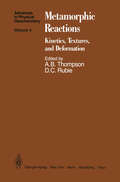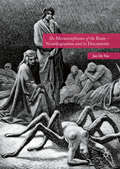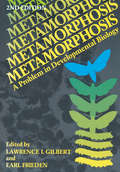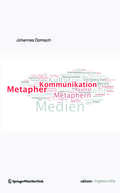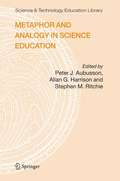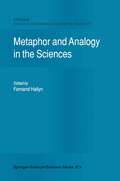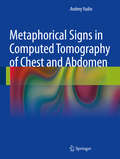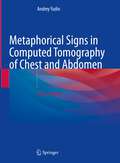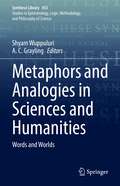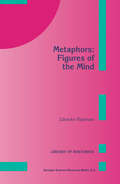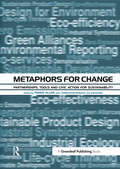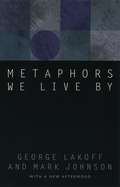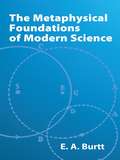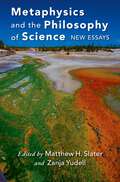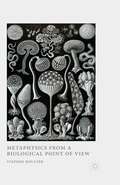- Table View
- List View
Metamorphic Reactions: Kinetics, Textures, and Deformation (Advances in Physical Geochemistry #4)
by B. Bayly K. H. Brodie M. A. Carpenter R. J. Knipe E. L. McLellan S.A.F. Murrell A. Putnis J. Ridley D. C. Rubie E. H. Rutter B. K. Smith A. B. Thompson R. J. Tracy R. P. WintschThe fourth volume in this series consists of eleven chapters. The first five deal with more theoretical aspects of the kinetics and mechanisms of meta morphic reactions, and the next six consider the interdependence of defor mation and metamorphism. All papers deal with natural processes that inter act on various time scales and with different degrees of mass and heat transfer. Consequently, many fundamental axioms of metamorphic petrol ogy and structural geology are questioned both for their accuracy and their usefulness. In raising such questions, most contributors have pointed to ways in which the answers could be forthcoming from appropriate experi mental studies or observations on natural materials. In their discussion of how order/disorder can influence mineral assem blages, Carpenter and Putnis emphasize that metastable crystal growth is common in metamorphic systems and state' 'there may be some reluctance (among many earth scientists) to accept that significant departures from equilibrium could occur." On the basis of presented evidence, they question whether reactions ever occur close to an equilibrium boundary. The neces sity for pressure or temperature overstepping is also required by nucleation rate theory. In any case, the degree of order is severely influenced by these kinetic effects in igneous, sedimentary, and metamorphic environments.
Metamorphic Rock - Formation
by RnibThis diagram shows how extreme heat and pressure are used to form metamorphic rock.
Metamorphic Rock - Formation (Tactile)
by RnibThis diagram shows how extreme heat and pressure are used to form metamorphic rock.
Metamorphoses of Hamiltonian Systems with Symmetries (Lecture Notes in Mathematics #1864)
by Konstantinos EfstathiouModern notions and important tools of classical mechanics are used in the study of concrete examples that model physically significant molecular and atomic systems. The parametric nature of these examples leads naturally to the study of the major qualitative changes of such systems (metamorphoses) as the parameters are varied. The symmetries of these systems, discrete or continuous, exact or approximate, are used to simplify the problem through a number of mathematical tools and techniques like normalization and reduction. The book moves gradually from finding relative equilibria using symmetry, to the Hamiltonian Hopf bifurcation and its relation to monodromy and, finally, to generalizations of monodromy.
The Metamorphoses of the Brain – Neurologisation and its Discontents
by Jan De VosWhat are we exactly, when we are said to be our brain? This question leads Jan De Vos to examine the different metamorphoses of the brain: the educated brain, the material brain, the iconographic brain, the sexual brain, the celebrated brain and, finally, the political brain. This first, protracted and sustained argument on neurologisation, which lays bare its lineage with psychologisation, should be taken seriously by psychologists, educationalists, sociologists, students of cultural studies, policy makers and, above all, neuroscientists themselves.
Metamorphosis: A Problem in Developmental Biology
by Lawrence Gilbert"The old order changeth, yielding place to new. " When Tennyson wrote this, he was unfamiliar with the pace of modem science else he would have said the new is displaced by the newer. When Gilbert and I gathered the papers for the first edition of this overview of metamorphosis, we aimed to provide a broad basis upon which the experimental analysis of the developmental changes called metamorphosis could proceed. We were both aware then that with the new techniques of biochemistry and with the revolutionary breakthrough to the nature of the gene, countless new possibilities were being opened for the exploration of the molecular basis of development. The resources offered by metamorphic changes offered unique opportunities to trace the path from gene to phenotype. Our expectations were high. I visited Larry Gilbert and Earl Frieden in their laboratories and saw with envy how far advanced they were then in the use of molecular methods of analysis. I had started on a different approach to develop an in vitro test for thyroid action on amphibian tissue. But circumstances limited my own progress to the initial delim itation of the technical possibilities of the in vitro system. Only from the sidelines could I watch the steady if slow progress of biology in penetrating the maze of molecular events by which animal tissues re spond to hormonal and other developmental factors.
Metapher Kommunikation (Edition Angewandte)
by Johannes DomsichAktuell durchlebt die Erste Welt bemerkenswerte Phasen: eine Hyperindividualisierung, die das Ich zum undiskutierten Herrscher von Entscheidungen, Lebensstrategien und Entwürfen erhebt. Technologie, das soziale Leben, Politik – alles unterwirft sich diesem Diktat. Wie ein Gegenentwurf dazu erscheinen der Wille und die Sehnsucht nach Kommunikation, nach einem Dialog, der im Getöse der medialisierten Welt der Datenautobahnen und Informationsfluten kaum mehr zu vernehmen ist. Schwierig ist es geworden, in der Vielfalt der Referenzen, Modelle und Rollen ein Bild zu finden, das das eigene Leben, das eigene Weltbild gelingen lässt. Woher sollte man die Steine des Welt- und des Ich-Kaleidoskops nehmen, wenn nicht aus den inflationären Medien und ihren Formaten? Das Ich ist nur so leistungsfähig, wie die Prothesen, die uns und unseren Sinnen durch die Technik zur Verfügung stehen. Das Bild vom Bild wird zur Referenz, zum alles bestimmenden Metaphernsystem. Mit Hilfe der Kulturtechniken haben wir uns die für uns so typische Distanz zur Realität erkämpft, nun müssen wir uns mit ihrer Hilfe auch eine neue Wirklichkeit einrichten, um den Begriff unserer Existenz nicht zu verlieren.
Metaphor and Analogy in Science Education (Contemporary Trends and Issues in Science Education #30)
by Peter J. Aubusson Allan G. Harrison Stephen M. RitchieYears ago a primary teacher told me about a great series of lessons she had just had. The class had visited rock pools on the seashore, and when she asked them about their observations they talked about: it was like a factory, it was like a church, it was like a garden, it was like our kitchen at breakfast time, etc. Each student’s analogy could be elaborated, and these analogies provided her with strongly engaged students and a great platform from which to develop their learning about biological diversity and interdependence. In everyday life we learn so many things by comparing and contrasting. The use of analogies and metaphors is important in science itself and their use in teaching science seems a natural extension, but textbooks with their own sparse logic, do not help teachers or students. David Ausubel in the 1960s had advocated the use of ‘advance organisers’ to introduce the teaching of conceptual material in the sciences, and some of these had an analogical character. However, research on the value of this idea was cumbersome and indecisive, and it ceased after just a few studies. In the 1980s research into children’s conceptions of scientific phenomena and concepts really burgeoned, and it was soon followed by an exploration of a new set of pedagogical strategies that recognised a student in a science class is much more than a tabula rasa.
Metaphor and Analogy in the Sciences (Origins: Studies in the Sources of Scientific Creativity #1)
by FernandHallynThis collection of papers contains historical case studies, systematic contributions of a general nature, and applications to specific sciences. The bibliographies of the contributions contain references to all central items from the traditions that are relevant today. While providing access to contemporary views on the issue, the papers illustrate the wide variety of functions of metaphors and analogies, as well as the many connections between the study of some of these functions and other subjects and disciplines.
Metaphorical Management: Using Intuition and Creativity as a Guiding Mechanism for Complex Systems
by Klaus ElleIn times of general instability change management is a great challenge. Our fossil mental patterns are not sufficient any more to be able to navigate sensibly the global scenario of complexity. Metaphorical thinking is a method which releases creative impulses into every change process and is of practical use, activating collective knowledge as a new network resource at the same time. This book reflects modern economy, ecology, sustainability and perception from an artistic perspective. However, it is not so much about "art", but rather how the modern artist takes on a serving role in the social arena again. He makes his creative knowledge available to connect processes of large-scale social development, he extends the boundaries of our scientifically limited world view and creates inspired playgrounds where the sensory-visionary can freely interact with the technically-necessary. This is no new aesthetic theory but rather a practical application of the creative process in operation at the crossroads of social interaction. Metaphorical thinking is emotionalized thinking and the observer is not separated from reality, but the centre, the starting point, of every change and new development. This volume offers creative ways to find solutions for a wide range of complex problems. It is a practical instrument for modern leadership and can be used to teach complexity in new ways. This work will help to create a global dialogue for sustainable change.Thsi book is also available in German: ISBN 978-90-481-9678-4
Metaphorical Signs in Computed Tomography of Chest and Abdomen
by Andrey YudinWhen analyzing the results of diagnostic imaging studies, the radiologist traditionally makes reference to particular features representative of normality or pathology. Most of these features are associated with images of the world around us. This pictorial issue contains nearly 400 illustrations and descriptions of more than 100 classic radiological signs of chest and abdominal diseases that are not named after authors but based on metaphors derived from contemplation of our environment. By correlating the results of computed tomography with these vivid descriptive images, readers will be able to memorize typical and often pathognomonic patterns of disease more quickly and more easily. This book will be of value for both radiology residents and more experienced radiologists.
Metaphorical Signs in Computed Tomography of Chest and Abdomen
by Andrey YudinThis richly illustrated book is devoted to radiologists’ ever-growing interest in discovering metaphors relevant for diagnostic imaging. In its second and completely revised edition, the book contains nearly 800 illustrations and descriptions of about 200 classic radiological signs of chest and abdominal diseases. These signs are based on metaphors from our daily environment and the world around us. By correlating the results of Computed Tomography (CT) with these vivid and descriptive images, readers will be able to memorize typical and often pathognomonic patterns of disease more quickly and easily. This book will be of value to both radiology residents and more experienced radiologists consultants.
Metaphors and Analogies in Sciences and Humanities: Words and Worlds (Synthese Library #453)
by Shyam Wuppuluri A. C. GraylingIn this highly-interdisciplinary volume, we systematically study the role of metaphors and analogies in (mis)shaping our understanding of the world. Metaphors and Analogies occupy a prominent place in scientific discourses, as they do in literature, humanities and at the very level of our thinking itself. But when misused they can lead us astray, blinding our understanding inexorably. How can metaphors aid us in our understanding of the world? What role do they play in our scientific discourses and in humanities? How do they help us understand and skillfully deal with our complex socio-political scenarios? Where is the dividing line between their use and abuse? Join us as we explore some of these questions in this volume.
Metaphors: Figures of the Mind (Library of Rhetorics #4)
by Z. RadmanThis book deals with various aspects of metaphorics and yet it is not only, or perhaps not even primarily, about metaphor itself. Rather it is concerned with the argument from metaphor. In other words, it is about what I think we can learn from metaphor and the possible consequences of this lesson for a more adequate understanding, for instance, of our mental processes, the possibilities and limitations of our reasoning, the strictures of propositionality, the cognitive effect of fictional projections and so on. In this sense it is not, strictly speaking, a contribution to metaphorology; instead, it is an attempt to define the place of metaphor in the world of overall human intellectual activity, exemplary thematized here in the span that ranges from problems relating to the articulation of meanings up to general issues of creativity. Most of the aspects discussed, therefore, are examined not so much for the sake of gaining some new knowledge about metaphor (work conducted in the »science of metaphor« is presently so huge that an extra attempt to spell out another theory of metaphor may have an infiatory effect); the basic strategy of this book is to view metaphor within the complex of language usage and language competence, in human thought and action, and, finally, to see in what philosophically relevant way it improves our knowledge of ourselves. Certainly, by adopting this basic strategy we also simultaneously increase our knowledge of metaphors, of their functions and importance.
Metaphors for Change: Partnerships, Tools and Civic Action for Sustainability
by Penny Allen Christophe Bonazzi David GeeHow can we get from where we are to where we want to be? Metaphors for Change attempts to answer this question and provide a roadmap for sustainability by bringing together the thoughts of a unique collection of leading change agents from business, government and academia. Environmental questions have previously been dealt with metaphorically, by catastrophism or manicheism (zero growth; Malthusianism, Deep Ecology; "man is the enemy"; less is more). These metaphors have had limited impact because they have failed to connect with the mainstream of cultural, political, and business ideas. This book examines a number of new metaphors – and related partnerships, tools and action – which appear to have greater possibilities for the world in which we now live. The editors argue that Metaphors for Change can deliver to the public and to decision-makers new perceptions ("structured knowledge") that can help interpret the past and the present, and help us forge the future. The wider the gap between the "now" and the "necessary", the stronger the bridging perceptions have to be in order to break through barriers of fear and conservatism. Some of the concepts considered are: sustainable development; the polluter pays principle; the precautionary principle; eco-efficiency; eco-effectiveness; life-cycle assessment; design for the environment; eco-services; dematerialization; industrial symbiosis; industrial ecology; and zero emissions. There are of course other useful metaphors on the horizon, some of them included in this book. Including key contributions from the ground-breaking conferences ECO 97 and ECO 99, along with other specially commissioned and reprinted pieces, Metaphors for Change provides a treasure chest of new ideas, innovations and action. Accessible and forward-thinking, it will prove indispensable both as a student learning tool and as a panoramic overview of the sustainability metaphors key thinkers believe we should be putting into practice.
Metaphors for Change: Partnerships, Tools and Civic Action for Sustainability
by Penny Allen Christophe Bonazzi David GeeHow can we get from where we are to where we want to be? Metaphors for Change attempts to answer this question and provide a roadmap for sustainability by bringing together the thoughts of a unique collection of leading change agents from business, government and academia. Environmental questions have previously been dealt with metaphorically, by catastrophism or manicheism (zero growth; Malthusianism, Deep Ecology; "man is the enemy"; less is more). These metaphors have had limited impact because they have failed to connect with the mainstream of cultural, political, and business ideas. This book examines a number of new metaphors – and related partnerships, tools and action – which appear to have greater possibilities for the world in which we now live. The editors argue that Metaphors for Change can deliver to the public and to decision-makers new perceptions ("structured knowledge") that can help interpret the past and the present, and help us forge the future. The wider the gap between the "now" and the "necessary", the stronger the bridging perceptions have to be in order to break through barriers of fear and conservatism. Some of the concepts considered are: sustainable development; the polluter pays principle; the precautionary principle; eco-efficiency; eco-effectiveness; life-cycle assessment; design for the environment; eco-services; dematerialization; industrial symbiosis; industrial ecology; and zero emissions. There are of course other useful metaphors on the horizon, some of them included in this book. Including key contributions from the ground-breaking conferences ECO 97 and ECO 99, along with other specially commissioned and reprinted pieces, Metaphors for Change provides a treasure chest of new ideas, innovations and action. Accessible and forward-thinking, it will prove indispensable both as a student learning tool and as a panoramic overview of the sustainability metaphors key thinkers believe we should be putting into practice.
Metaphors We Live By
by George Lakoff Mark JohnsonThe now-classic Metaphors We Live By changed our understanding of metaphor and its role in language and the mind. Metaphor, the authors explain, is a fundamental mechanism of mind, one that allows us to use what we know about our physical and social experience to provide understanding of countless other subjects. Because such metaphors structure our most basic understandings of our experience, they are "metaphors we live by"—metaphors that can shape our perceptions and actions without our ever noticing them. In this updated edition of Lakoff and Johnson's influential book, the authors supply an afterword surveying how their theory of metaphor has developed within the cognitive sciences to become central to the contemporary understanding of how we think and how we express our thoughts in language.
Metaphors We Live By
by George Lakoff Mark JohnsonThe now-classic Metaphors We Live By changed our understanding of metaphor and its role in language and the mind. Metaphor, the authors explain, is a fundamental mechanism of mind, one that allows us to use what we know about our physical and social experience to provide understanding of countless other subjects. Because such metaphors structure our most basic understandings of our experience, they are "metaphors we live by"—metaphors that can shape our perceptions and actions without our ever noticing them. In this updated edition of Lakoff and Johnson's influential book, the authors supply an afterword surveying how their theory of metaphor has developed within the cognitive sciences to become central to the contemporary understanding of how we think and how we express our thoughts in language.
Metaphors We Live By
by George Lakoff Mark JohnsonThe now-classic Metaphors We Live By changed our understanding of metaphor and its role in language and the mind. Metaphor, the authors explain, is a fundamental mechanism of mind, one that allows us to use what we know about our physical and social experience to provide understanding of countless other subjects. Because such metaphors structure our most basic understandings of our experience, they are "metaphors we live by"—metaphors that can shape our perceptions and actions without our ever noticing them. In this updated edition of Lakoff and Johnson's influential book, the authors supply an afterword surveying how their theory of metaphor has developed within the cognitive sciences to become central to the contemporary understanding of how we think and how we express our thoughts in language.
Metaphors We Live By
by George Lakoff Mark JohnsonThe now-classic Metaphors We Live By changed our understanding of metaphor and its role in language and the mind. Metaphor, the authors explain, is a fundamental mechanism of mind, one that allows us to use what we know about our physical and social experience to provide understanding of countless other subjects. Because such metaphors structure our most basic understandings of our experience, they are "metaphors we live by"—metaphors that can shape our perceptions and actions without our ever noticing them. In this updated edition of Lakoff and Johnson's influential book, the authors supply an afterword surveying how their theory of metaphor has developed within the cognitive sciences to become central to the contemporary understanding of how we think and how we express our thoughts in language.
The Metaphysical Foundations of Modern Science
by E. A. BurttTo the medieval thinker, man was the center of creation and all of nature existed purely for his benefit. The shift from the philosophy of the Middle Ages to the modern view of humanity’s less central place in the universe ranks as the greatest revolution in the history of Western thought, and this classic in the philosophy of science describes and analyzes how that profound change occurred. A fascinating analysis of the works of Copernicus, Kepler, Galileo, Descartes, Hobbes, Gilbert, Boyle, and Newton, it not only establishes the reasons for the triumph of the modern perspective, but also accounts for certain limitations in this view that continue to characterize contemporary scientific thought. A criticism as well as a history of the change that made possible the rise of modern science, this volume is also a guide to understanding the methods and accomplishments of the great philosopher-scientists of the sixteenth and seventeenth centuries.
Metaphysics and Philosophy of Science in the Seventeenth and Eighteenth Centuries: Essays in honour of Gerd Buchdahl (The Western Ontario Series in Philosophy of Science #43)
by R. S. WoolhouseThe essays in this collection have been written for Gerd Buchdahl, by colleagues, students and friends, and are self-standing pieces of original research which have as their main concern the metaphysics and philosophy of science of the seventeenth and eighteenth centuries. They focus on issues about the development of philosophical and scientific thought which are raised by or in the work of such as Bernoulli, Descartes, Galileo, Kant, Leibniz, Maclaurin, Priestly, Schelling, Vico. Apart from the initial bio-bibliographical piece and those by Robert Butts and Michael Power, they do not discuss Buchdahl or his ideas in any systematic, lengthy, or detailed way. But they are collected under a title which alludes to the book, Metaphysics and the Philosophy of Science: The Classical Origins, Descartes to Kant (1969), which is central in the corpus of his work, and deal with the period and some of the topics with which that book deals.
Metaphysics and the Philosophy of Science: New Essays
by Matthew H. Slater and Zanja YudellThe question of the proper role of metaphysics in philosophy of science is both significant and contentious. The last few decades have seen considerable engagement with philosophical projects aptly described as "the metaphysics of science:" inquiries into natural laws and properties, natural kinds, causal relations, and dispositions. At the same time, many metaphysicians have begun moving in the direction of more scientifically-informed ("scientistic" or "naturalistic") metaphysics. And yet many philosophers of science retain a deep suspicion about the significance of metaphysical investigations into science. This volume of new essays explores a broadly methodological question: what role should metaphysics play in our philosophizing about science? These new essays, written by leading philosophers of science, address this question both through ground-level investigations of particular issues in the metaphysics of science and by more general methodological inquiry.
Metaphysics and the Philosophy of Science: New Essays
by Matthew Slater Zanja YudellThe question of the proper role of metaphysics in philosophy of science is both significant and contentious. The last few decades have seen considerable engagement with philosophical projects aptly described as "the metaphysics of science:" inquiries into natural laws and properties, natural kinds, causal relations, and dispositions. At the same time, many metaphysicians have begun moving in the direction of more scientifically-informed ("scientistic" or "naturalistic") metaphysics. And yet many philosophers of science retain a deep suspicion about the significance of metaphysical investigations into science. This volume of new essays explores a broadly methodological question: what role should metaphysics play in our philosophizing about science? These new essays, written by leading philosophers of science, address this question both through ground-level investigations of particular issues in the metaphysics of science and by more general methodological inquiry.
Metaphysics from a Biological Point of View
by S. BoulterMany philosophers in the analytic tradition are now convinced that metaphysical questions are worth pursuing, but we still lack a convincing meta-metaphysics and methodology. This essay offers an account of how we should conduct our business qua metaphysicians.
